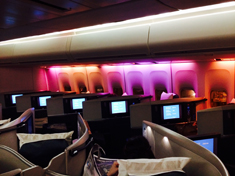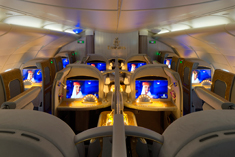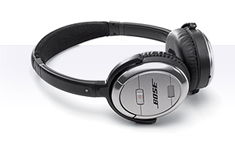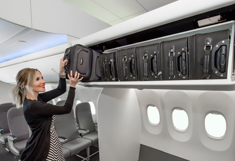 TINTED WINDOWS
TINTED WINDOWS
AVAILABLITY On all Boeing 787 Dreamliners
AIRLINES 17, including All Nippon Airways, Air New Zealand, China Southern, Japan Airlines and Qatar Airways.
HOW IT WORKS Unlike the conventional plastic window shades we’re used to being told to open and shut at various points throughout our intercontinental journeys, the windows on the Dreamliner are made from "smart glass". True to their name, these windows cleverly adjust the surface’s opacity according to five pre-set degrees of tinting. The cabin attendants can centrally adjust the dimness when needed, so during sleep times they may limit the passengers' own ability to let sunlight in.
WHY WE LOVE IT Gone are the days when that one passenger seated near us decides to yank open the window shade and half-blind everyone with the scorching sunlight flooding in. But then again, if you're one who loves to be in control, you may have to put up with the frustration of having some superior force dictating how much light is good for you.
MOOD LIGHTING
AVAILIBILITY Mood lighting is a standard feature on Boeing’s 787 Dreamliner and it is now installed on the majority of newly delivered widebodies, ranging from the B747-8 to the B777 and A330.
AIRLINES Various, including Air India, British Airways and China Southern
HOW IT WORKS By blending many shades of colours, mood lighting creates an atmosphere of calm and relaxation inside the plane. Multiple lighting schemes help complement different phases of flight, i.e. warm rays of artificial sunlight on the aircraft’s interior ceiling for sunrise and starry skies during the night.
WHY WE LOVE IT Come on now, who doesn’t like starry skies? Not just kind on the eyes, they are said to be sleep-inducing and might just do the trick to help us doze off. And we surely prefer waking up to the golden glow of "sunrise" instead of the conventional inflight cabin lighting.
 SEATS WITH MASSAGE FUNCTION
SEATS WITH MASSAGE FUNCTION
AVAILIBILITY Varies
AIRLINES The feature is available on most airlines’ premium cabins, e.g. Cathay Pacific, Asiana Airlines, Korean Air, Lufthansa and Qatar Airways.
HOW IT WORKS It’s a massage chair – do we need to explain further?
WHY WE LOVE IT Being confined to an airplane seat and remaining inactive for extended periods of time is bad. Very bad. Plus your muscles start to ache and soon you’ll be complaining about getting old and having a wrecked back. Trust us, we know. Having a massage function in your seat helps iron the kinks out in order to relieve pressure and strain from your muscles. And you might just arrive at your destination feeling like a whole new person.
NOISE-CANCELLING HEADPHONES
AVAILABILITY Varies
AIRLINES Most modern carriers offer noise-cancelling headphones in their premium cabins, including Singapore Airlines, Cathay Pacific and Korean Air.
HOW IT WORKS Ironically, the first noise-cancelling headphones ever developed came about when Amar Bose, the founder of Bose Corporation, first used a pair of airline headphones that he later found to be nearly useless in the face of the roar of the aircraft engines.
There are two types of noise reduction options available – active and passive. Active noise reduction is achieved through electronics, in which the headphones actively produce sound waves that are of the same amplitude and frequency as the background noise. This identical yet opposing signal basically cancels out unwanted sound.
Meanwhile, passive noise reduction is provided through the use of sound-absorbent materials, or thick high-density foam, which prevents external sounds from entering users’ ears. High quality headphones are capable of reducing noise by up to 80 decibels (db) – enough to drown out the average 85-90db inside a B747 cabin.
WHY WE LOVE IT Imagine having to replay a quiet scene on 24 again and again because you just can’t catch any goddamn thing Kiefer Sutherland is "whisper-talking" about because the cabin noise drowns out everything. Not only do noise-cancelling headphones prevent this from happening, the absence of background noise helps create the illusion of a surround-sound system. Epic, isn't it? Besides, we all know that any noise louder than 85db is potentially dangerous to our health, right?
 SPACE BINS
SPACE BINS
AVAILABILITY Next-Generation B737s and B737MAX
AIRLINE The yet-to-be-released feature will launch in late 2015 on Alaska Airlines’ new aircraft deliveries.
HOW IT WORKS According to Boeing, the new overhead compartments dubbed "Space Bins" are similar to the current pivot bins. Unlike Airbus’ overhead compartment doors that open upwards, Boeing’s rendition allows passengers to actually lower the overhead section, thereby allowing easier access for shorter individuals.
The Space Bins will allow a maximum of six standard size carry-on bags (measuring 23cm x 36cm x 56cm) to be stowed – two more than the current pivot bins hold.
WHY WE LOVE IT We’ve all seen them: passengers with such oversized carry-on bags that they themselves can't even lift high enough to the overhead bin. And even when they manage to reach the bin, they keep struggling to put the bag in because, as the law of physics would have it, an item can't fit into a storage space smaller than it. And then they are holding up other passengers trying to board. While we think the better solution is for airlines to enforce size limits on carry-on bags and make these inconsiderate individuals check their bags at the gate, we also understand it is impossible to totally stamp out this bad behavior. If you can't beat it, accommodate it – at least we can make boarding smoother. Space Bins – we love you already.
Dominic Sebastian Lalk and Reggie Ho








